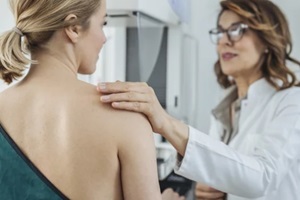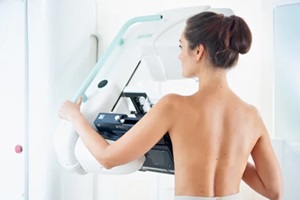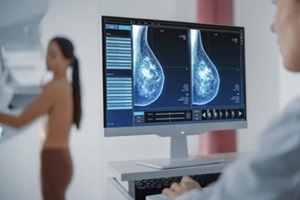 Mammograms are pivotal in early breast cancer detection, which significantly improves treatment success rates. But confusion often surrounds screening guidelines concerning when to start mammograms, how frequently to get them, and what technologies serve you best.
Mammograms are pivotal in early breast cancer detection, which significantly improves treatment success rates. But confusion often surrounds screening guidelines concerning when to start mammograms, how frequently to get them, and what technologies serve you best.
Read on for expert recommendations so you can monitor your breast health at optimal intervals.
What Is a Mammogram?
A mammogram is a low-energy X-ray scan that allows radiologists to examine breast tissue for abnormalities that could indicate cancer. Specialized mammography machines take images from two angles of each breast, which technicians carefully compress to even out layers during imaging.
Standard 2D mammography produces two-dimensional pictures. On the other hand, 3D breast tomosynthesis, also called 3D mammography, uses multiple X-rays at various angles to reconstruct detailed, layered images showing fine gradations of tissue density. This improves early tumor detection and reduces false positive recall rates of patients for further testing.
When to Start Getting Mammograms
Most major medical organizations, including the American Cancer Society (ACS), now advise starting yearly mammogram screening at age 40 for women at average risk of breast cancer.
Previously, guidance suggested waiting until age 50. However, statistical data on modern cancer trends show that beginning annual monitoring in a patient’s 40s finds more early-stage tumors and saves more lives.
The ACS does leave the choice open for women 40-44 years old to start screening anytime during that decade. Waiting gives you a few more years before accumulating radiation exposure. However, beginning mammograms immediately at 40 provides maximum protection against aggressive cancers.
Essentially, it’s a choice between accumulating a small degree of radiation exposure and potentially discovering you have a serious disease when it’s progressed to a serious degree.
Ideally, you should talk to your gynecologist about whether to start at 40 or closer to 45 based on your risk factors.
How Often to Get Screened
For women 45 years and older, authoritative groups such as the ACS and American College of Radiology recommend continuing yearly mammogram screening.
Evidence clearly shows that finding cancers at the earliest stages reduces mortality rates compared to cases where larger tumors that have already spread to lymph nodes are detected, which is why staying vigilant and getting screened annually is essential.
At age 55, guidelines say healthy women without risk factors for breast cancer can optionally switch to biennial screenings every two years instead of annually.
 While most breast cancer patients are 50 years or older, when it does occur in younger patients, it tends to be more aggressive, indicating that tumors may grow more slowly in older patients.
While most breast cancer patients are 50 years or older, when it does occur in younger patients, it tends to be more aggressive, indicating that tumors may grow more slowly in older patients.
So, longer intervals may still catch cancers in time for favorable treatment while cutting radiation exposure and false positive recalls.
High-Risk Groups Need Earlier and More Frequent Monitoring
Women with elevated breast cancer risk due to genetic mutations, strong family history, or previous chest radiation should start yearly mammograms as early as age 30.
They might need supplementary annual breast MRI scanning as well. Talk to your physician about whether you meet high-risk criteria warranting earlier and more intensive surveillance.
Knowing When to Stop Mammogram Screenings
At a certain point, screening is no longer advised for elderly women or those with serious health conditions. When life expectancy falls below 10 years due to age or illness, the benefits of finding slower-growing cancers no longer outweigh the potential downsides of over-testing or overtreatment. Discuss with your doctor an appropriate age for you to stop mammogram screenings.
Spotlight on Breast Density
Breast density is a risk factor that plays an increasingly prominent role in customized screening protocols. Breasts contain varying proportions of fibroglandular tissue versus fatty tissue, with dense breasts having a higher amount of the former versus the latter.
Why does density matter? Dense breasts demonstrate higher cancer risk while also making tumors more challenging to spot on mammograms.
Cancerous cells often start multiplying within gland tissue. Substantial densities hide small lesions that would stand out clearly against largely fatty backgrounds.
Radiologists grade breast density into four categories when reading mammograms. Those with heterogeneously or extremely dense classifications may qualify for supplemental ultrasound or breast MRI screening.
However, density can change over time, so each new mammogram report should be checked. Discuss options with your gynecologist if your last mammogram showed dense breasts.
What About Breast Self-Awareness?
What about breast self-exams? Performing regular structured self-checks following precise palpation patterns lacks solid proof for boosting early cancer detection.
Tumors often grow too deep or subtly to feel. And there’s no apparent connection between an improvement in mortality rates when self-exams are done in addition to mammogram screening.
However, it’s smart to stay generally self-aware by noticing skin changes or new lumps between mammograms. If you feel anything unusual as you go about normal activities, report it promptly without waiting for your next scheduled mammogram.
A Look at Mammogram Limitations and Downsides
 While extremely useful for early detection, mammograms cannot prevent tumors from initially forming. They also cannot diagnose all breast diseases.
While extremely useful for early detection, mammograms cannot prevent tumors from initially forming. They also cannot diagnose all breast diseases.
Mammograms occasionally miss fast-growing cancers or those that spread using pathways that aren’t easily seen, such as lymphatics. And overdiagnosis represents a downside risk when testing finds non-threatening oddities that may never have impacted your health.
Partner With Raleigh Gynecology & Wellness for Evidence-Based Breast Wellness Care
Remaining up to date on mammography based on the latest medical guidance is among the most meaningful health investments you can make. Raleigh Gynecology & Wellness provides compassionate counseling on the appropriate timelines for your individual risk profile.
Contact us today at (919) 636-6670 or online to discuss keeping your breasts safe, whether through 2D or advanced 3D mammography personalized to your needs.
